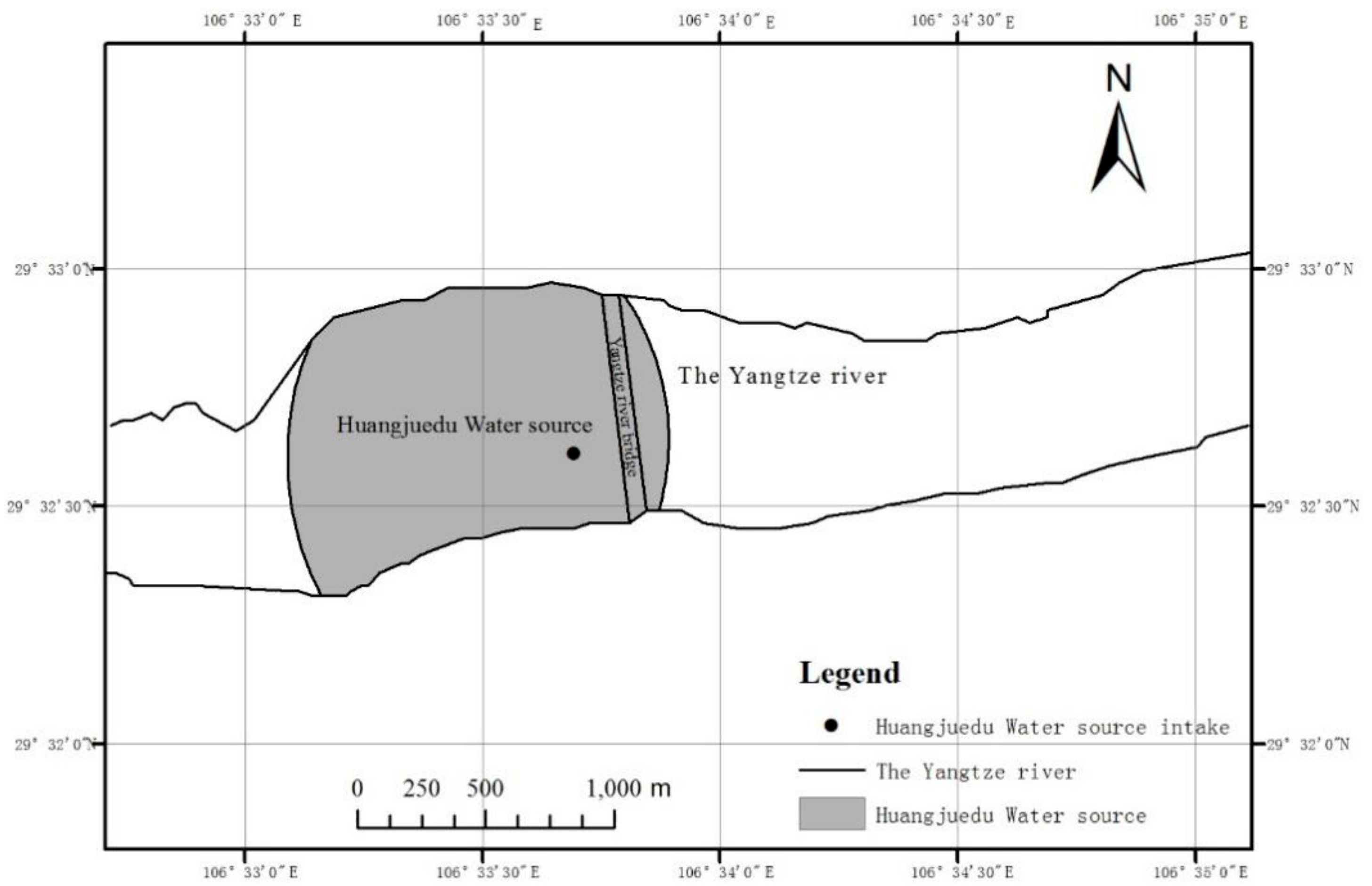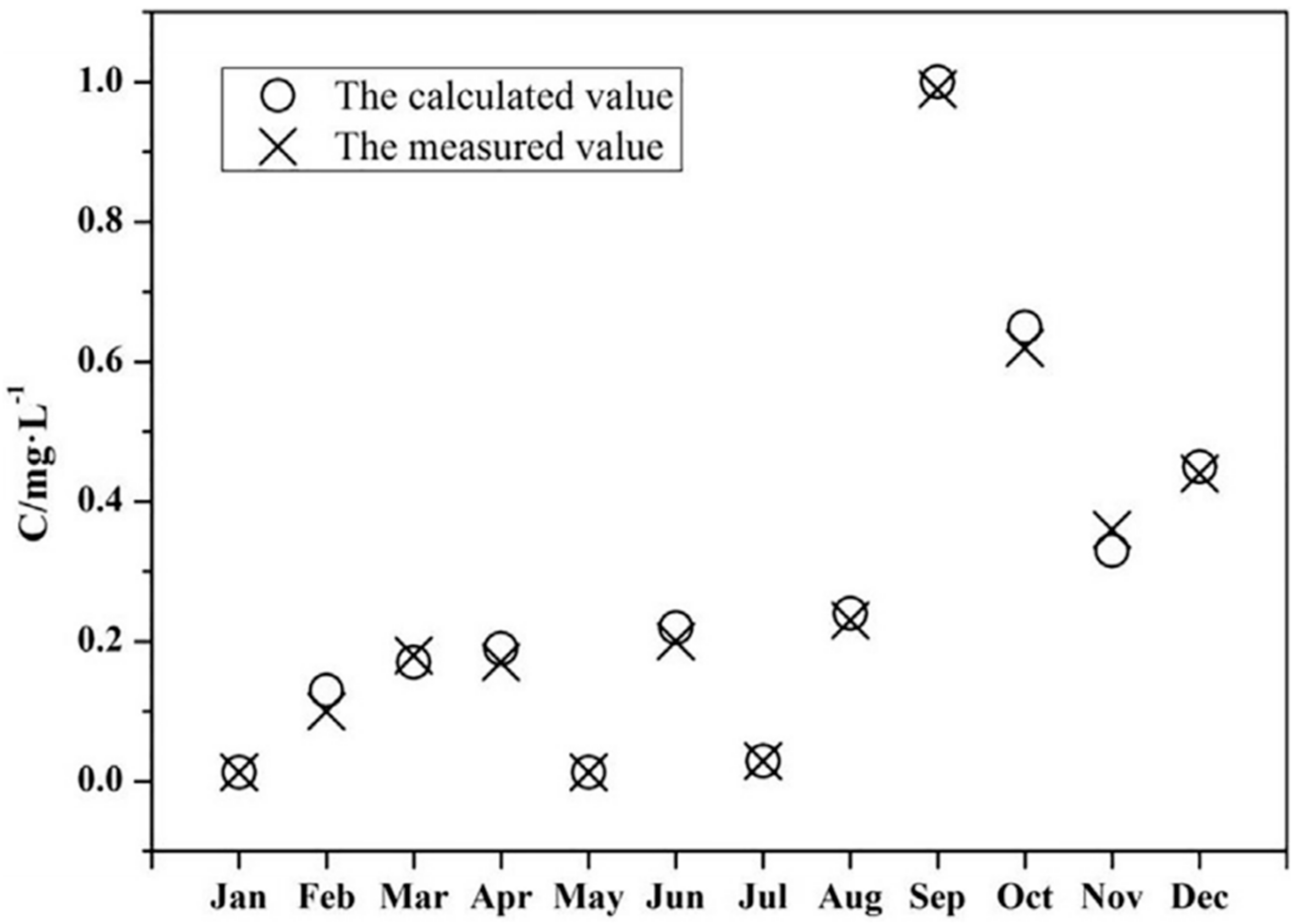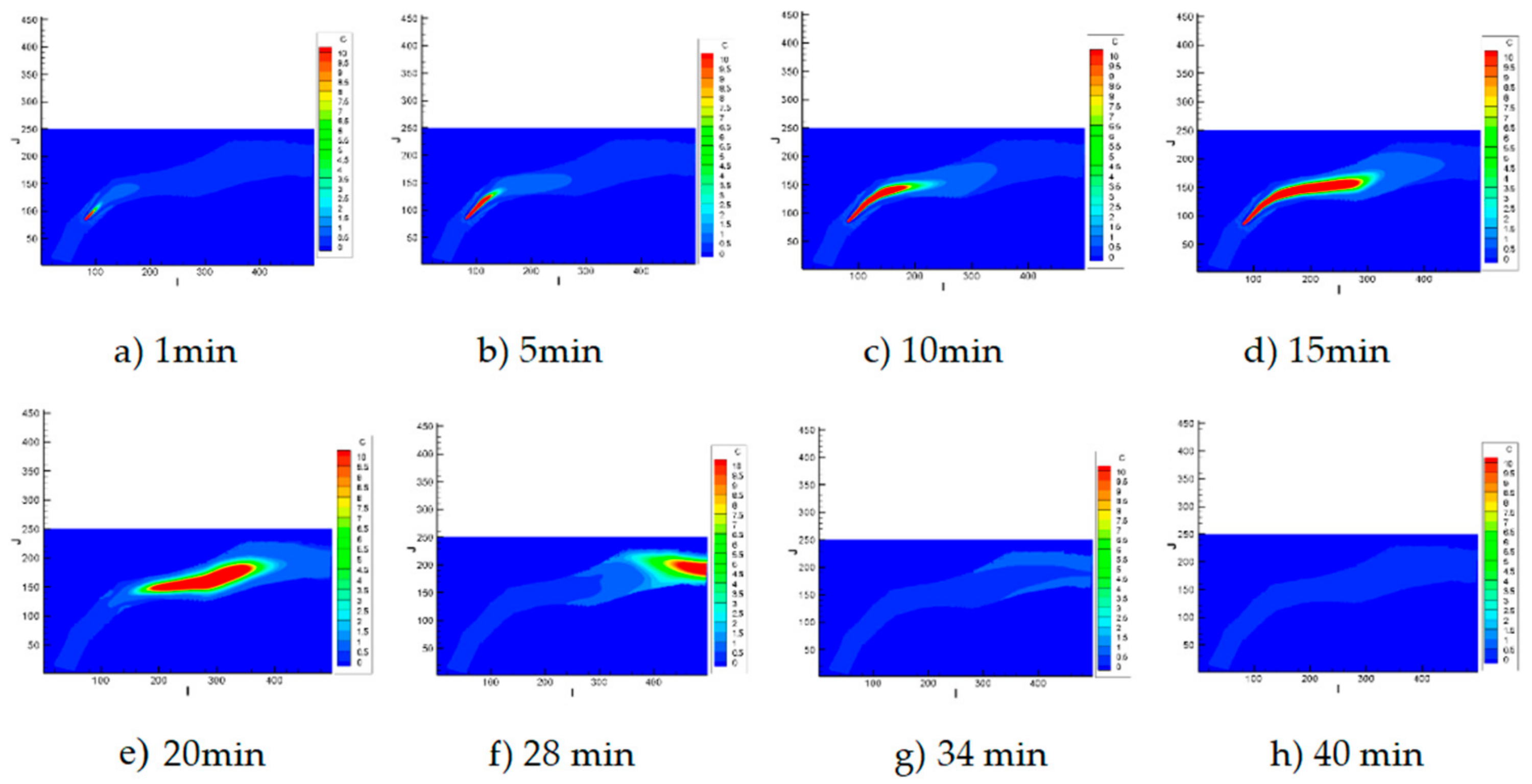Safety Guarantee System of Drinking Water Source in Three Gorges Reservoir Area and Its Application in Huangjuedu Drinking Water Source Area
Abstract
1. Introduction
2. Materials and Methodology
2.1. Methodology
2.1.1. Fundamental Mathematical Models of Water Quality
2.1.2. Discrete Method
2.2. System Development
3. Model Application
3.1. Study Area
3.2. Source Term
3.3. Accident Process Simulation
3.3.1. Boundary Conditions
3.3.2. Initial Conditions
3.3.3. Determination of River Roughness
3.3.4. Parameter Calibration
4. Results and Discussion
4.1. Spatiotemporal Variation of Ammonia Nitrogen Pollutant in Dry Period
4.2. Spatiotemporal Variation of Ammonia Nitrogen Pollutant in Flow Period
4.3. Spatiotemporal Variation of Ammonia Nitrogen Pollutant in Flood Period
4.4. Spatiotemporal Variation of Ammonia Nitrogen Pollutant in Storage Period
5. Conclusions
Author Contributions
Funding
Acknowledgments
Conflicts of Interest
References
- Wang, X.; Wang, Z.; Yang, W.T.; Xi, X.; Shi, L.; Dong, W. Shortage of Water Resources in China and Countermeasures. J. Environ. Eng. 2014, 32, 1–5. [Google Scholar]
- Liu, R.Z.; Zhang, K.; Zhang, Z.J.; Borthwick, A.G.L. Water-Scale Environmental Risk Assessment of Accident Water Pollution: The Case of Laoguan River, China. J. Environ. Inform. 2018, 31, 87–96. [Google Scholar]
- Wantzen, M.K.; Alves, C.B.; Badiane, S.D. Urban Stream and Wetland Restoration in the Global South—A DPSIR Analysis. J. Sustain. 2019, 11, 49–75. [Google Scholar]
- Ren, Y.H.; Xiao, Y.T. Construction of emergency system for sudden water pollution accident. J. Environ. Sci. Manag. 2007, 32, 10–13. [Google Scholar]
- Boryczko, K.; Bartoszek, L.; Koszelnik, P.; Rak, J.R. A new concept for risk analysis relating to the degradation of water reservoirs. J. Environ. Sci. Pollut. R 2018, 25, 25591–25599. [Google Scholar] [CrossRef] [PubMed]
- Hou, J.; Hu, F.P. Emergency treatment of sudden water pollution accident. J. Jiangxi Chem. 2009, 9, 49–51. [Google Scholar]
- Tao, Y.; Ren, H.T.; Xia, J.X. Investigation on disposal effect of different countermeasure of sudden water pollution accident. J. Basic Sci. Eng. 2013, 21, 203–213. [Google Scholar]
- Zheng, H.Z.; Lei, X.H.; Shang, Y.Z. Sudden Water Pollution Accidents and Reservoir Emergency Operations: Impact Analysis at Danjiangkou Reservoir. J. Environ. Technol. 2018, 39, 787–803. [Google Scholar] [CrossRef]
- Lin, L.; Li, C.; Yang, W.J.; Zhao, L.Y.; Liu, M.; Li, Q.Y.; Crittenden, J.C. Spatial variations and periodic changes in heavy metals in surface water and sediments of the Three Gorges Reservoir, China. J. Chemosphere 2020, 240, 124837. [Google Scholar] [CrossRef]
- Khaiter, P.A.; Erechtchoukova, M.G. Conceptualizing an Environmental Software Modeling Framework for Sustainable Management Using UML. J. Environ. Inform. 2019, 34, 123–138. [Google Scholar] [CrossRef]
- Zhang, B.; Qin, Y.; Hao, Q.T. A temporal-spatial simulation and dynamic regulation system of water quality on sudden water pollution accidents. J. Wuhan Univ. 2013, 38, 1108–1112. [Google Scholar] [CrossRef]
- Zhang, B.; Qin, Y.; Huang, M.X. SD-GIS-based temporal-spatial simulation of water quality in sudden water pollution accidents J. Comput. Geosci. 2011, 37, 874–882. [Google Scholar] [CrossRef]
- Slaughter, A.R. Simulating Microbial Water Quality in Data-Scarce Catchments: An Update of the WQSAM Model to Simulate the Fate of Escherichia coli. Water Resour. Manag. 2017, 31, 4239–4252. [Google Scholar] [CrossRef]
- Hu, J.; Sun, L.; Li, C.H.; Wang, X.; Jia, X.L.; Cai, Y.P. Water Quality Risk Assessment for the Laoguanhe River of China Using a Stochastic Simulation Method. J. Environ. Inform. 2018, 31, 123–136. [Google Scholar] [CrossRef]
- Lu, D.L.; Li, K.Q.; Liang, S.K.; Lin, G.H.; Wang, X.L. A coastal three-dimensional water quality model of nitrogen in Jiaozhou Bay linking field experiments with modelling. J. Mar. Pollut. Bull. 2017, 114, 53–63. [Google Scholar] [CrossRef] [PubMed]
- Chen, Z.; Zhu, Z.; Yin, L. The Changing Water Quality Characteristics from Urban Drinking Water Sources in Guangdong, China. Water Resour. Manag. 2015, 29, 987–1002. [Google Scholar] [CrossRef]
- Malagó, A.; Vigiak, O.; Bouraoui, F.; Pagliero, L.; Franchini, M. The Hillslope Length Impact on SWAT Streamflow Prediction in Large Basins. J. Environ. Inform. 2018, 32, 82–97. [Google Scholar] [CrossRef]
- Chorin, A.J. Numerical solution of the Navier-Stokes equations. J. Am. Math. Comput. 1968, 22, 745–762. [Google Scholar] [CrossRef]
- Patanker, S.V.; Splding, D.B.A. Calculation procedure for heat, mass and momentum transfer in three dimensional parabloic flow. Int. J. Heat Mass Transf. 1972, 15, 1787–1806. [Google Scholar] [CrossRef]
- Sheng, Y.; Zhang, T.; Jiang, Z.Z. A stabilized finite volume method for the stationary navier–stokes equations Chaos Solitons and Fractals the Interdisciplinary. J. Nonlinear Sci. Nonequilib. Complex Phenom. 2016, 89, 363–372. [Google Scholar]
- Ding, X.W.; Zhu, Q.; Zhai, A.F.; Liu, L. Water quality safety prediction model for drinking water source areas in Three Gorges Reservoir and its application. J. Ecol. Indic. 2019, 101, 734–741. [Google Scholar] [CrossRef]
- Ding, X.W.; Wang, S.Y.; Jiang, G.H. A simulation program on change trend of pollutant concentration under water pollution accidents and its application in Heshangshan drinking water source area. J. Clean. Prod. 2017, 167, 326–336. [Google Scholar] [CrossRef]
- Nematian, J. An Extended Two-stage Stochastic Programming Approach for Water Resources Management under Uncertainty. J. Environ. Inform. 2016, 27, 72–84. [Google Scholar] [CrossRef]
- Ding, X.W.; Fang, P. Accident Trend Prediction of Heavy Metal Pollution in the Heshangshan Drinking Water Source Area Based on Integrating a Two-Dimensional Water Quality Model and GIS. J. Sustain. 2019, 11, 3998. [Google Scholar] [CrossRef]
- Versteeg, H.K.; Malalasekera, W. An Introduction to Computational Fluid Dynamics: The Finite Volume Method; Pearson Prentice Hall: New York, NY, USA, 1995; pp. 157–167. [Google Scholar]
- Blosch, E.; Shyy, W.; Smith, R. The role of mass conservation in pressure-based algorithm. Numer. Heat Transf. 1993, 24, 415–429. [Google Scholar] [CrossRef]
- Salma, T. A combined treatment method of novel Mass Bio System and ion exchange for the removal of ammonia nitrogen from micro-polluted water bodies. J. Chem. Eng. J. 2019, 378, 122217. [Google Scholar]
- Zhang, Y.J.; Zhang, Y.H.; Wang, L.J. Application of Emergency Water Environment Risk Area Partitioning in the Three Gorges Reservoir Environmental. J. Sci. Technol. 2015, 32, 15–21. [Google Scholar]
- Fu, J.C.; Hsu, M.H.; Duan, Y. Development of roughness updating based on artificial neural network in a river hydraulic model for flash flood forecasting. J. Earth Syst. Sci. 2016, 125, 1–14. [Google Scholar] [CrossRef]
- Qu, Z.G.; Tao, W.Q.; He, Y.L. Implementation of CLEAR Algorithm on Collocated Grid System and Application Examples. Numer. Heat Transf. 2004, 1, 65–96. [Google Scholar] [CrossRef]
- Zhang, Y.Y.; Xia, J. Study on optimal water and water quality scheduling model of sluice dam based on SWAT model. J. Hydroelectr. 2010, 29, 159–164. [Google Scholar]
- Brown, R.T. A Two-Dimensional Reservoir Water Quality Model: User’s Guide R. In Center for the Management, Utilization, and Protection of Water Resources; Tennessee Technological University: Cookeville, TN, USA, 1985. [Google Scholar]
- Chen, B.; Li, P.; Wu, H.J.; Husain, T.; Khan, F. MCFP: A Monte Carlo Simulation-based Fuzzy Programming Approach for Optimization under Dual Uncertainties of Possibility and Continuous Probability. J. Environ. Inform. 2017, 29, 88–97. [Google Scholar] [CrossRef]
- Zheng, M.S.; Ma, L.K.; Li, T.H.; Huang, R. Rapid Assessment Method for Eco-water Deficit in Catchments. J. Environ. Inform. 2017, 30, 149–160. [Google Scholar] [CrossRef]
- Morar, F.; Iantovics, L.B.; Gligor, A. Analysis of Phytoremediation Potential of Crop Plants in Industrial Heavy Metal Contaminated Soil in the Upper Mures River Basin. J. Environ. Inform. 2018, 31, 1–14. [Google Scholar]







| Continuity Equation | Momentum Equation | Water Quality Equation | |
|---|---|---|---|
| u v | c | ||
© 2019 by the authors. Licensee MDPI, Basel, Switzerland. This article is an open access article distributed under the terms and conditions of the Creative Commons Attribution (CC BY) license (http://creativecommons.org/licenses/by/4.0/).
Share and Cite
Tang, X.; Zhai, A.; Ding, X.; Zhu, Q. Safety Guarantee System of Drinking Water Source in Three Gorges Reservoir Area and Its Application in Huangjuedu Drinking Water Source Area. Sustainability 2019, 11, 7074. https://doi.org/10.3390/su11247074
Tang X, Zhai A, Ding X, Zhu Q. Safety Guarantee System of Drinking Water Source in Three Gorges Reservoir Area and Its Application in Huangjuedu Drinking Water Source Area. Sustainability. 2019; 11(24):7074. https://doi.org/10.3390/su11247074
Chicago/Turabian StyleTang, Xiaoling, Aifeng Zhai, Xiaowen Ding, and Qiande Zhu. 2019. "Safety Guarantee System of Drinking Water Source in Three Gorges Reservoir Area and Its Application in Huangjuedu Drinking Water Source Area" Sustainability 11, no. 24: 7074. https://doi.org/10.3390/su11247074
APA StyleTang, X., Zhai, A., Ding, X., & Zhu, Q. (2019). Safety Guarantee System of Drinking Water Source in Three Gorges Reservoir Area and Its Application in Huangjuedu Drinking Water Source Area. Sustainability, 11(24), 7074. https://doi.org/10.3390/su11247074




